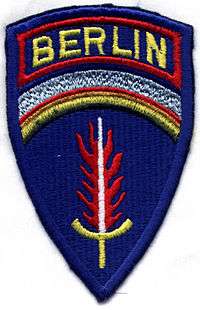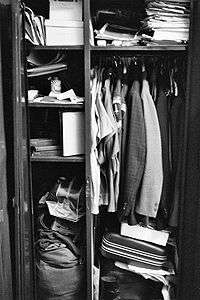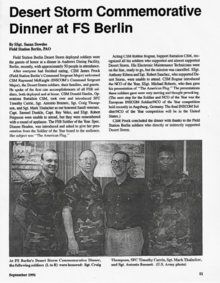Berlin Brigade
The Berlin Brigade was a US Army brigade-sized garrison based in West Berlin during the Cold War. After the end of World War II, under the conditions of the Yalta and Potsdam agreements, the Allied forces occupied West Berlin. This occupation lasted throughout the Cold War. The French Army also had units in Berlin, called Forces Françaises à Berlin and the British Army's unit in Berlin was the Berlin Infantry Brigade.

%2C_lieutenant_Colonel_Alexander_Dorofeev._(Soviet_Union)._W.Berlin.1981.jpg)

History
The Berlin Brigade of the United States Army was a separate brigade based in Berlin. Its shoulder sleeve insignia was the U.S. Army Europe patch with a Berlin tab, later incorporated.
During the Berlin Wall Crisis of 1961, the Army reorganized the command structure of the forces in Berlin and created the U.S. Army Berlin and created the Berlin Brigade from the units already in the city. The 6th Infantry Regiment,[1] active in Germany since 1950, was reorganized in mid-1958 according to the Pentomic structure: Each battle group consisted of five line (rifle) companies, a combat support company, and a headquarters & headquarters company. The Berlin Brigade had the 2nd[2] and 3rd Battle Groups, 6th Infantry until 1963, when Army force structure abandoned battle groups in favor of brigades and subordinate battalions.
The reorganized brigade consisted of the following units:
- 2nd Battalion, 6th Infantry
- 3rd Battalion, 6th Infantry
- 4th Battalion, 18th Infantry (reflagged on 13 September 1972 as the 4th Battalion, 6th Infantry)[3]
- Battery C, 94th Field Artillery
- Company F (later 6th Battalion), 40th Armor (Turner Barracks)
- 42nd Engineer Company
- 42nd AG Unit (Postal)
- 42nd Military Police Group (Customs) (attached elements)
- 287th Military Police Company (Separate)
- 43rd Chemical Detachment
- 76th Chemical Detachment
- 279th Station Hospital (became US Army Hospital Berlin in 1976)
- 168th Medical Detachment (Veterinary Service)
- 592nd Signal Company
- 298th Army Band
- AFN Europe AM FM TV
- Rail Transportation Office -RTO (Berlin Licherfelde West train station)
- Berlin Brigade Aviation Detachment (Tempelhof Central Airport)
- US Army Engineers-DEH Detachment Engineering & Housing (Von Steuben compound)
- US Military Liaison Mission Potsdam -USMLM
- Detachment A - 39th Special Forces Operational Detachment (1956-1990)
The 168th and 298th share the distinction of being the longest-serving units in Berlin. They both arrived in the city in a 37-vehicle convoy on 3 July 1945. The commanders of both units were old high school classmates.
The brigade's infantry battalions were reflagged again in 1984 as the 4th, 5th and 6th Battalions, 502nd Infantry Regiment, and Battery C, 94th FA was reflagged as Battery E, 320th Field Artillery.
From 1947 to 1987, brigade soldiers were tasked with month-long rotations at Spandau Prison. These rotations, shared with British, French and Soviet soldiers, continued until Spandau's last prisoner, Rudolf Hess, died in 1987.
Until the end of the Cold War, members of the brigade were eligible for the Army of Occupation Medal with Germany clasp. Because of the legal status of West Berlin, it was technically occupied territory left over from World War II.
During the early 1980s, the U.S. Army Regimental System initiative renamed a large percentage of infantry, armor and artillery battalions to align overseas commands with units assigned to stateside brigades, reinforcing the Army's regimental designations and unit morale. The original intent was to initiate personnel replacement and rotations within regiments,[4] a "next step" that did not provide sufficient flexibility to Army personnel managers. The impact on Berlin-based infantry battalions was to reflagged the 2nd, 3rd and 4th Battalions, 6th Infantry as the 4th, 5th and 6th Battalions, 502nd Infantry, respectively, during the summer of 1984, assigning Berlin infantry units a shared identification with infantry battalions of 2nd Brigade, 101st Airborne Division (Air Assault) at Fort Campbell, Kentucky.
When the Berlin Wall fell in 1989, the operational structure of the Brigade was as follows:
- Berlin Brigade
- 4th Bn, 502nd Infantry Regiment, (6x M106, 12x M901, 14x M113, 8x M125)
- 5th Bn, 502nd Infantry Regiment, (6x M106, 12x M901, 14x M113, 8x M125)
- 6th Bn, 502nd Infantry Regiment, (6x M106, 12x M901, 14x M113, 8x M125)
- Combat Support Battalion
- HHC, (2x M1A1)
- D Company, 40th Armor Regiment, (14x M1A1)
- F Company, 40th Armor Regiment, (14x M1A1)
- E Battery, 320th Field Artillery Regiment, (8x M109A3)
- 42nd Engineer Company (3x M728 CEV)
- 42nd Postal Unit
- AFN Europe AM FM TV
- 43rd Chemical Detachment
- 766th Military Intelligence Detachment
- Berlin Brigade Aviation Detachment (6x Bell UH-1H, 2x Pilatus UV-20A Chiricahua, 1x Beechcraft C-12C Huron)
- US Military Liaison Mission Potsdam -USMLM
- US Army Signal Support Company

Individual members of the brigade with Intelligence specialties from 766 Military Intelligence Detachment & Field Station Berlin, deployed to Operations Desert Shield and Desert Storm in 1990–1991, filling short falls for other units in USAREUR But the first Berlin Brigade units to take part in an out-of-theater operation were the command-and-staff element of Headquarters and Headquarters Company (HHC), as well as one platoon from Company D, 6th Battalion, 502nd Infantry, and the 42nd Engineer Company. These units were later joined by the members of the 42nd AG Unit (Postal). These units served in Operation Provide Comfort II, a relief and protection mission for Iraqi Kurds. They served with a multinational "Allied Ground Combat Force" that also included British, French, Italian, Dutch, and Turkish infantry companies. Based in Silopi, Turkey, near the Iraqi border, from July to October 1991, these ground forces were soon withdrawn to avoid entanglement in the local Turkish-PKK conflict and because it was decided that the US Air Force presence at Incirlik constituted an adequate deterrent to Iraqi attempts at encroaching on the Kurdish autonomous zone. Soldiers of this task force were authorized to wear the Berlin Brigade shoulder sleeve insignia as a combat patch on the right shoulder of their uniform, the first and only time elements of the Berlin Brigade were authorized to do so.
Elements of the Berlin Brigade were the first combat units selected to deploy as a member of the United Nations Protectionary Forces (UNPROFOR) to Macedonia in July 1993; later to be renamed Task Force Able Sentry.
Under the treaties that enabled the reunification of Germany, all non-German military forces were required to leave Berlin. The Berlin Brigade was officially inactivated by President Bill Clinton on 6 July 1994. The last unit to leave Berlin was the 42nd AG Unit (Postal). The 42nd was a small unit responsible for the mail service for the military assigned to Berlin, the Potsdam unit, and the Helmstedt detachment. It received very little recognition but was vital to the morale of the brigade Besides postal service, the unit also performed other services, such as courier duty throughout the European theater. The unit was based at Andrews Barracks under Special Troops.
Historical notes
The 287th Military Police Company was the only US Army MP unit to use boats for water patrol along the border to East Germany.
The Berlin Brigade Aviation Detachment at Tempelhof Central Airport was the last US Army unit worldwide to use the DeHavilland Canada U-6 Beaver, when retired in January 1980. Its replacement was the UV-20A Chiricahua (two delivered in 1979),for which the unit was also the first and until 1991 only operator within the US ARMY.[5]
The Rail Transportation Office operated the only regular US Army Transportation Corps trains (between West Berlin and West Germany) through a communist controlled country for 45 years, pulled by east German Deutsche Reichsbahn locomotives.
See also
- Forces Françaises à Berlin
- Berlin Infantry Brigade
References
- "6th Infantry". History.army.mil. Retrieved 25 November 2017.
- "2d Battalion, 6th Infantry Regiment". History.army.mil. Retrieved 25 November 2017.
- U.S. Army Center of Military History (CMH). "4th Battalion, 6th Infantry Regiment | Lineage and Honors | U.S. Army Center of Military History (CMH)". History.army.mil. Retrieved 25 November 2017.
- "Army Regulation 600-82, The U.S. Army Regimental System" (PDF). Archived from the original (PDF) on 22 July 2011. Retrieved 20 May 2011.
- |url=http://www.theberlinobserver.com/archive/1980V36/V36_N7_feb15.pdf| title=Page 5 Last two U-6s retired berlin Observer 15 February 1980 |publisher=http://www.theberlinobserver.com |accessdate=2019-06-10}}
Bibliography
- William Durie, "The United States Garrison Berlin 1945-1994", Aug 2014, ISBN 978-1630685409.
- AMTLICH GEWONNEN; considering the spirit during the Berlin Wall period, including a dedication to the former personnel of 7350th Air Base Group, Großek, Michael (2012) ISBN 978-3-89950-993-9
- Kevin Wright and Peter Jefferies "Looking down the corridors-Allied aerial espionage over East Germany and Berlin 1945-1990",2015, ISBN 978-0-7509-7947-4.
External links
| Wikimedia Commons has media related to Berlin Brigade. |
- USA 6941st Guard Veterans Association
- 248 German Security Unit Veterans Association
- Allied Museum Berlin
- History of the French, American and British Berlin Brigades
- Berlin Brigade - McNair Barracks
- Berlin 1969 – the Allies in Berlin at midpoint of the Cold War
- Co F 40th Armor site by Bob Decker.
- Berlin U.S. Military Veterans Association (BUSMVA) website
- Berlin-Brigade Installations
- "West Alliierte in Berlin". The history of the three Western Allied Forces and their civilian employees in Berlin from 1945–1994.
- BerlinBrigade.com Dedicated to all that served in West Berlin from 1945 to 1994
- USMLM recce flights in the Berlin Control Zone BCZ